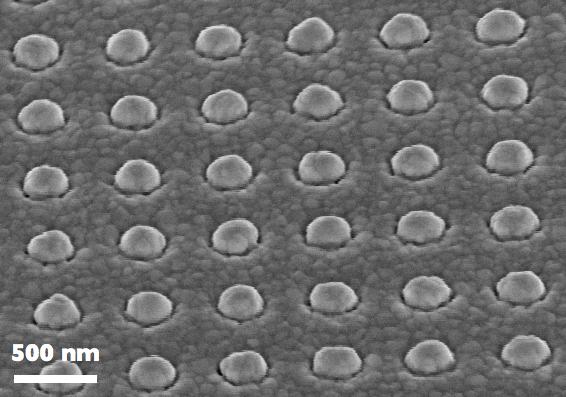
Photo by Scott Robinson (Clearly Ambiguous) via flickr.
Solar energy is a huge market and any improvement to the efficiency of solar cells has a significant impact. In 2008, worldwide photovoltaic solar energy production was about 5 gigawatts, and this is expected to rise to 15 gigawatts in 2015. To put this figure in context, a nuclear reactor produces around 1 to 1.5 gigawatts of electricity.
The overall conversion efficiency of the best solar cell devices, with complex designs that include multiple materials, reaches up to about 50%. For more common silicon-based solar cells efficiencies are around 20%, although commercial photovoltaic panels achieve even less than that. Any enhancement in solar cell efficiency, whether it is in terms of costs or in terms of efficiency, is therefore highly desirable and significant. If all photovoltaic cells that produce those 5 gigawatts of energy were only 5% more efficient, for example with 21% conversion efficiency instead of 20%, it would result in an increase in energy production equivalent to about 250 megawatts.
Another issue is cost. Bulk solar cells are better at catching more sunlight, but use more material and therefore cost a lot more than thin-film films. Albert Polman, Harry Atwater and colleagues have now developed a solar cell design that enhances the power efficiency of thin solar cells. In their study published in Optics Express they are able to enhance the efficiency of a 340 nanometer thick silicon solar cell by 27% when compared to a regular thin-film cell.

The efficiency of solar cells can be enhanced by plasmonic effects. On the left metallic nanoparticles scatter light into the solar cell and trap it there. Note the metallic mirror on the back. On the right the local enhancement of the optical field caused by surface plasmons leads to an increased absorption of light. Reprinted by permission from Macmillan Publishers Ltd. Nature Materials 9, 205-213 (2010).
Since the first commercially relevant solar cells were developed in 1954, efficiencies have improved considerably from the few percent of the first solar cells. Purifying the materials used, mostly silicon, has reduced losses arising from imperfections in the material.
A more recent strategy is to improve the interaction between light and the solar cell, because the longer the light travels through the solar cell the more likely it is that it gets absorbed. Indeed, some of the most efficient silicon solar cells use structured surfaces that guide the light into the cells and suppress detrimental back reflections of the light. However, the laws of classical optics say that such structures need to be of a size at least half of the wavelength of light, which is hundreds of nanometers. Too much for thin-film solar cells.
A suitable approach for thin-film solar cells, however, is to use the strong antenna effects of gold nanoparticles, which defy conventional optics and are suitable for thin films. Around gold nanoparticles light is highly concentrated and scattered by so-called plasmonic effects. Sprinkle some gold or silver nanoparticles on the surface of a solar cell and they focus light better into the device. However, although this increases the performance of the solar cell because concentrated light has a better chance of being absorbed, the gold obviously also obstructs some of the surface.

Silver nanostructures at the back contacts of solar cells for enhanced light absorption. Courtesy of Albert Polman.
Polman, Atwater and colleagues now incorporated a plasmonic layer made from silver not on the surface but at the back of the solar cell. Their design uses silver patterns about 290 nanometers wide that arranged in a square array with periodicity of about 500 nanometers. In this way, the light travels through the solar cell first. Only the fraction of light that is not absorbed the first time round on its path through the cell gets focussed back by the nanopatterns. This enhances light absorption particularly for red light, which is less efficiently absorbed by silicon.
The 27% enhancement over a conventional flat design is certainly significant for a field where improvements in the single digits are considered a notable advance. Still, it remains uncertain whether this approach could lead to record-breaking efficiencies that can improve on fully optimized solar cells made from thick films. Rather, the advantage is that very thin films of silicon can be used without losing out on the efficiencies of thicker films. This not only lowers fabrication costs, but the low weight of these solar panels also reduces installation costs, which are a significant contribution to the economics of solar cell installations. The biggest test of this technology will now be whether it can make it into the cut-throat solar cell market.
References:
Ferry, V., Verschuuren, M., Li, H., Verhagen, E., Walters, R., Schropp, R., Atwater, H., & Polman, A. (2010). Light trapping in ultrathin plasmonic solar cells Optics Express, 18 (S2) DOI: 10.1364/OE.18.00A237
Further reading:
Atwater, H., & Polman, A. (2010). Plasmonics for improved photovoltaic devices Nature Materials, 9 (3), 205-213 DOI: 10.1038/nmat2629


August 31, 2010 at 15:29
“a nuclear reactor produces around 1 to 1.5 megawatts of electricity.” – 3 orders of magnitude error.
“it would result in an increase in energy production equivalent to about 150 nuclear reactors” – sounds like you believed the figure at the first place.
August 31, 2010 at 15:35
You are perfectly right, Anton! I had looked it up but somehow switched to megawatts. In any case, I corrected the text at the locations that you indicate. Thanks for spotting this!